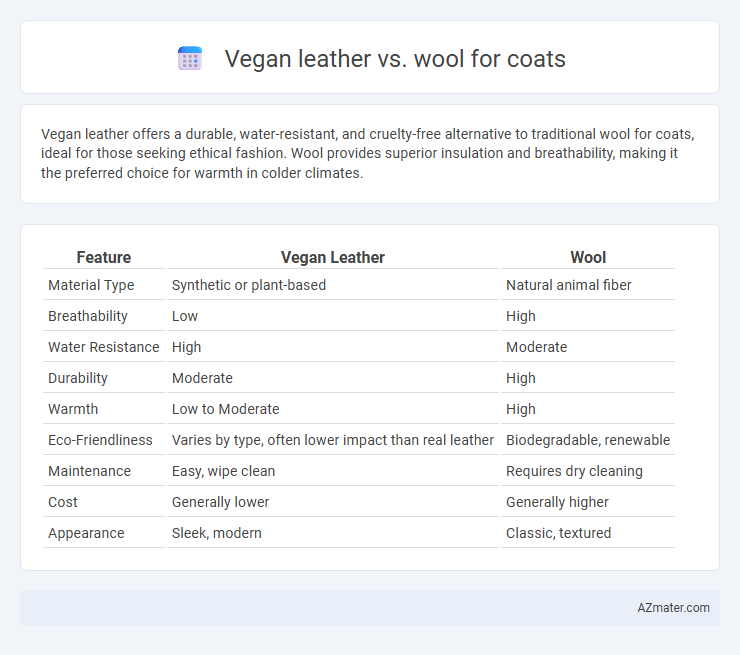Vegan leather offers a durable, water-resistant, and cruelty-free alternative to traditional wool for coats, ideal for those seeking ethical fashion. Wool provides superior insulation and breathability, making it the preferred choice for warmth in colder climates.
Table of Comparison
| Feature | Vegan Leather | Wool |
|---|---|---|
| Material Type | Synthetic or plant-based | Natural animal fiber |
| Breathability | Low | High |
| Water Resistance | High | Moderate |
| Durability | Moderate | High |
| Warmth | Low to Moderate | High |
| Eco-Friendliness | Varies by type, often lower impact than real leather | Biodegradable, renewable |
| Maintenance | Easy, wipe clean | Requires dry cleaning |
| Cost | Generally lower | Generally higher |
| Appearance | Sleek, modern | Classic, textured |
Introduction: Vegan Leather vs Wool for Coats
Vegan leather and wool represent two distinct materials commonly used for coats, each offering unique benefits and characteristics. Vegan leather provides a cruelty-free, water-resistant alternative with a sleek, modern aesthetic, while wool excels in insulation, breathability, and natural moisture-wicking properties. Understanding the differences in durability, warmth, and environmental impact is crucial when choosing between vegan leather and wool for outerwear.
Material Origins and Production
Vegan leather is typically made from synthetic materials like polyurethane or natural sources such as cork and pineapple leaves, offering a cruelty-free alternative to animal hides. Wool is a natural fiber harvested from sheep, involving shearing processes that emphasize sustainable and renewable resource use. Production of vegan leather can involve chemical treatments with environmental impacts, while wool production centers around animal husbandry practices and land management.
Environmental Impact Comparison
Vegan leather typically has a lower carbon footprint than traditional leather but often relies on synthetic materials like polyurethane, which are derived from fossil fuels and can contribute to microplastic pollution. Wool is a renewable resource with natural biodegradability, but its environmental impact includes methane emissions from sheep and intensive land use for grazing. Choosing between vegan leather and wool for a coat requires weighing synthetic pollution against animal agriculture's greenhouse gas emissions and land impact.
Durability and Longevity
Vegan leather offers high durability with resistance to water and stains, making it a practical choice for outerwear exposed to various weather conditions. Wool, naturally resilient and breathable, provides superior longevity due to its natural fiber structure that resists wear and tear over time. While vegan leather maintains its appearance with minimal maintenance, wool enhances durability through its ability to trap heat and resist abrasion, making both materials suitable for long-lasting coats depending on user preference.
Comfort and Wearability
Vegan leather offers a sleek, water-resistant surface that resists stains and is easy to clean, making it ideal for outerwear with a modern look and moderate breathability. Wool provides superior warmth and natural insulation, with excellent moisture-wicking properties that enhance comfort during cold weather but can feel heavier and less flexible than vegan leather. For wearability, wool coats typically allow better airflow and adaptability to temperature changes, while vegan leather performs well in urban settings due to its durability and wind resistance.
Ethical Considerations
Vegan leather, made from synthetic or plant-based materials, offers a cruelty-free alternative to traditional leather, reducing animal exploitation and environmental harm caused by livestock farming. Wool, derived from sheep, raises concerns related to animal welfare, including practices like mulesing and intensive farming, although ethically sourced and organic wool can mitigate these issues. Choosing vegan leather supports a more sustainable and animal-friendly fashion industry, while ethical wool requires strict certification to ensure humane treatment and ecological responsibility.
Style and Aesthetic Varieties
Vegan leather coats offer a sleek, edgy aesthetic with a polished finish that complements modern and urban styles, available in various colors and textures like matte, glossy, or embossed patterns. Wool coats provide a timeless, classic look with rich texture and natural drape, ideal for sophisticated and versatile outfits, featuring a broad range of weaves, weights, and patterns such as herringbone or plaid. The choice between vegan leather and wool influences the visual tone of a coat, from contemporary minimalism to traditional elegance, allowing for distinct style expressions.
Maintenance and Care Requirements
Vegan leather coats require regular cleaning with a damp cloth and mild soap to prevent cracking and maintain flexibility, while avoiding excessive heat and direct sunlight to preserve color and texture. Wool coats demand gentle dry cleaning to prevent shrinkage and maintain softness, with periodic brushing to remove surface dirt and proper storage to avoid moth damage. Both materials benefit from attentive care routines, but wool typically needs more specialized treatment to ensure longevity and appearance.
Cost and Accessibility
Vegan leather coats generally offer a more affordable price point compared to wool, making them accessible to a wider range of consumers looking for budget-friendly outerwear. Wool coats, often sourced from natural fibers like merino or cashmere, tend to be pricier due to the higher cost of raw materials and the complex processing involved. While vegan leather is widely available in fast fashion and mainstream retailers, wool coats may require shopping at specialty stores or premium brands to ensure quality and authenticity.
Final Verdict: Which is Better for Coats?
Vegan leather offers water resistance, durability, and a sleek modern aesthetic, making it ideal for urban coats, while wool provides superior insulation, breathability, and natural moisture-wicking properties, perfect for colder climates. The final verdict hinges on your priorities: choose vegan leather for style and easy maintenance, or opt for wool to benefit from warmth and comfort in harsh weather. Both materials have eco-friendly options, but wool's biodegradability gives it a slight edge in sustainability for long-term use.

Infographic: Vegan leather vs Wool for Coat
 azmater.com
azmater.com